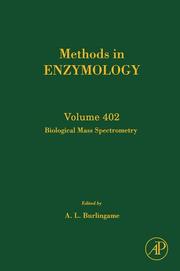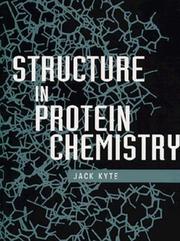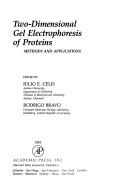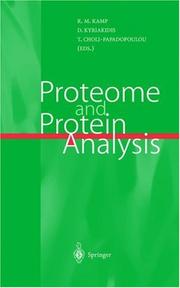| Listing 1 - 10 of 41 | << page >> |
Sort by
|
Book
ISBN: 1299442765 0124045960 0124017347 9780124045965 9780124017344 Year: 2013 Publisher: Amsterdam : Elsevier,
Abstract | Keywords | Export | Availability | Bookmark
 Loading...
Loading...Choose an application
- Reference Manager
- EndNote
- RefWorks (Direct export to RefWorks)
Low-Abundance Proteome Discovery addresses the most critical challenge in biomarker discovery and progress: the identification of low-abundance proteins. The book describes an original strategy developed by the authors that permits the detection of protein species typically found in very low abundance and that may yield valuable clues to future discoveries. Known as combinatorial peptide ligand libraries, these new methodologies are one of the hottest topics related to the study of proteomics and have applications in medical diagnostics, food quality, and plant analysis. The book is
Proteins - Analysis. --- Proteins -- Analysis. --- Proteomics. --- Proteomics - Methodology. --- Proteomics -- Methodology. --- Proteomics --- Proteins --- Human Anatomy & Physiology --- Health & Biological Sciences --- Animal Biochemistry --- Methodology --- Analysis --- Methodology. --- Analysis. --- Molecular biology
Book
ISBN: 0128003359 0128002794 Year: 2015 Publisher: Amsterdam, [Netherlands] : Academic Press,
Abstract | Keywords | Export | Availability | Bookmark
 Loading...
Loading...Choose an application
- Reference Manager
- EndNote
- RefWorks (Direct export to RefWorks)
The critically acclaimed laboratory standard for almost 50 years, Methods in Enzymology is one of the most highly respected publications in the field of biochemistry. Each volume is eagerly awaited, frequently consulted, and praised by researchers and reviewers alike. Now with over 520 volumes and 40,000 chapters in the collection, much of the material is still relevant today and is truly an essential publication for researchers in all fields of life sciences, including microbiology, biochemistry, cancer research, and genetics, just to name a few. In this volume, number 545, we have brought
Enzymes -- Analysis. --- Proteins -- Analysis. --- Proteins -- Purification. --- Proteins --- Enzymes --- Analysis. --- Purification. --- Proteids --- Biomolecules --- Polypeptides --- Proteomics

ISBN: 0121828107 9780121828103 Year: 2005 Volume: 405 Publisher: Amsterdam Elsevier Academic Press.
Abstract | Keywords | Export | Availability | Bookmark
 Loading...
Loading...Choose an application
- Reference Manager
- EndNote
- RefWorks (Direct export to RefWorks)
Also available on the World Wide Web
Biomolecules --- Proteins --- Glycoconjugates --- Glycolipids --- Enzymes --- Mass Spectrometry --- Analysis --- analysis --- analysis. --- Human Anatomy & Physiology --- Health & Biological Sciences --- Animal Biochemistry --- Biomolecules - Analysis --- Proteins - Analysis --- Glycoconjugates - Analysis --- Glycolipids - Analysis --- Glycoconjugates - analysis --- Glycolipids - analysis --- Proteins - analysis. --- Acqui 2006

ISBN: 0121828077 9780121828073 Year: 2005 Volume: 402 Publisher: Amsterdam Elsevier Academic Press.
Abstract | Keywords | Export | Availability | Bookmark
 Loading...
Loading...Choose an application
- Reference Manager
- EndNote
- RefWorks (Direct export to RefWorks)
Proteins --- Mass Spectrometry --- Proteomics. --- Biomolecules --- Analysis --- Human Anatomy & Physiology --- Health & Biological Sciences --- Animal Biochemistry --- Proteins - Analysis --- Biomolecules - Analysis --- Acqui 2006
Book
ISBN: 0123809223 9786612699979 0123809231 1282699970 9780123743992 9780123809223 0123743990 Year: 2009 Publisher: Amsterdam ; Boston : Elsevier / AP,
Abstract | Keywords | Export | Availability | Bookmark
 Loading...
Loading...Choose an application
- Reference Manager
- EndNote
- RefWorks (Direct export to RefWorks)
This MIE volume provides laboratory techniques that aim to predict the structure of a protein which can have tremendous implications ranging from drug design, to cellular pathways and their dynamics, to viral entry into cells.Expert researchers introduce the most advanced technologies and techniques in protein structure and foldingIncludes techniques on tiling assays.
Proteins -- Analysis. --- Proteins -- Conformation. --- Proteins -- Structure. --- RNA. --- Proteins --- Conformation. --- Analysis. --- Ribonucleic acid --- Ribose nucleic acid --- Protein conformation --- Nucleic acids --- Ribose

ISBN: 0896033392 0896033384 1603272593 9780896033382 Year: 1996 Publisher: Totowa Humana press
Abstract | Keywords | Export | Availability | Bookmark
 Loading...
Loading...Choose an application
- Reference Manager
- EndNote
- RefWorks (Direct export to RefWorks)
In The Protein Protocols Handbook, I have attempted to provide a cross-section of analytical techniques commonly used for proteins and peptides, thus providing a benehtop manual and guide both for those who are new to the protein chemistry laboratory and for those more established workers who wish to use a technique for the first time. We each, of course, have our own favorite, commonly used gel system, g- staining method, blotting method, and so on; I'm sure you will find yours here. H- ever, I have also described a variety of altematives for many of these techniques; though they may not be superior to the methods you commonly use, they may nev- theless be more appropriate in a particular situation. Only by knowing the range of techniques that are available to you, and the strengths and limitations of these te- niques, will you be able to choose the method that best suits your purpose.
Analytical biochemistry --- Proteins --- Protéines --- analysis --- handbooks --- Analysis --- Handbooks, manuals, etc --- Analyse --- Guides, manuels, etc. --- -#WDIR:vfm2 --- Proteids --- Biomolecules --- Polypeptides --- Proteomics --- Mass spectrometry. --- Proteins -- Analysis -- Handbooks, manuals, etc. --- Proteins -- Analysis. --- Proteins. --- Proteomics. --- Handbooks --- Clinical Laboratory Techniques --- Peptides --- Amino Acids, Peptides, and Proteins --- Investigative Techniques --- Publication Formats --- Chemicals and Drugs --- Publication Characteristics --- Analytical, Diagnostic and Therapeutic Techniques and Equipment --- Animal Biochemistry --- Human Anatomy & Physiology --- Health & Biological Sciences --- handbooks. --- Handbooks. --- Protéines --- Life sciences. --- Biochemistry. --- Life Sciences. --- Biochemistry, general. --- Biological chemistry --- Chemical composition of organisms --- Organisms --- Physiological chemistry --- Biology --- Chemistry --- Medical sciences --- Biosciences --- Sciences, Life --- Science --- Composition --- #WDIR:vfm2 --- Proteins - Analysis - Handbooks, manuals, etc. --- Proteins - analysis - handbooks

ISBN: 0815317018 9780815317012 Year: 1995 Publisher: New York (N.Y.): Garland
Abstract | Keywords | Export | Availability | Bookmark
 Loading...
Loading...Choose an application
- Reference Manager
- EndNote
- RefWorks (Direct export to RefWorks)
General biophysics --- General biochemistry --- Proteins --- Structure. --- Analysis. --- 547.96 --- -#WSCH:FYS3 --- #WSCH:WBIO --- Proteids --- Biomolecules --- Polypeptides --- Proteomics --- Analysis --- 547.96 Proteins --- #WSCH:FYS3 --- Structure --- Proteins - Structure. --- Proteins - Analysis.

ISBN: 012164720X 0323147917 9780121647209 Year: 1984 Publisher: Academic press
Abstract | Keywords | Export | Availability | Bookmark
 Loading...
Loading...Choose an application
- Reference Manager
- EndNote
- RefWorks (Direct export to RefWorks)
Polyacrylamide gel electrophoresis --- Proteins --- Analysis --- Polyacrylamide gel electrophoresis. --- Analysis. --- Electrophoresis, Polyacrylamide gel --- PAGE (Biochemistry) --- Polyacrylamide disc electrophoresis --- Gel electrophoresis --- Zone electrophoresis --- Proteins - Analysis

ISBN: 3540658912 3642640605 3642596312 9783540658917 Year: 1999 Publisher: Berlin Springer
Abstract | Keywords | Export | Availability | Bookmark
 Loading...
Loading...Choose an application
- Reference Manager
- EndNote
- RefWorks (Direct export to RefWorks)
Selected papers presented at the MPSA 98 are covering new, sensitive and rapid methods for the analysis of proteins, with special emphasis on the total cell proteins, the proteome. In addition to the experimental details, the advantages and limitations of the methodological approaches are discussed. Topics included are: Protein sequencing analysis, protein and peptide sample preparation, mass spectrometry, NMR, analysis of post-translational modifications, purification of recombinant proteins, protein-protein and protein-DNA interactions, structure prediction, modeling and protein folding, functional implications of protein domains and newly emerging methods for the investigation of the proteome, allowing to analyse the expression of genes.
Proteins --- #WSCH:WBIO --- 575.113 --- 575.113 Gene. Genetic apparatus. Genome --- Gene. Genetic apparatus. Genome --- Analysis --- Proteins analysis --- Proteins. --- Proteids --- Biomolecules --- Polypeptides --- Proteomics --- Monograph --- Biochemistry. --- Cell biology. --- Biochemistry, general. --- Cell Biology. --- Cell biology --- Cellular biology --- Biology --- Cells --- Biological chemistry --- Chemical composition of organisms --- Organisms --- Physiological chemistry --- Chemistry --- Medical sciences --- Composition --- Proteins - Analysis
Book
ISBN: 9780815344469 0815344465 Year: 2012 Publisher: New York, N.Y. Garland Science
Abstract | Keywords | Export | Availability | Bookmark
 Loading...
Loading...Choose an application
- Reference Manager
- EndNote
- RefWorks (Direct export to RefWorks)
How Proteins Workis a clear, up-to-date and authoritative account of the principles that govern the way proteins work. This book will provide advanced undergraduate students in biochemistry and biophysics in vivo context for the standard protein sequence-structure-function model. The text will also serve as a valuable resource for graduate students and researchers looking for a reference on the fundamentals underlying protein function.
General biochemistry --- Molecular biology --- Analytical biochemistry --- proteïnen --- Proteins. --- Proteins --- Biochemistry. --- Biophysics. --- Protéines --- Biochimie --- Biophysique --- Analysis. --- Analyse --- Biochemistry --- Biophysics --- Analysis --- Protéine --- proteins --- Enzymes --- Acide aminé --- Amino acids --- 577.112 --- 577.112 Proteins --- Protéines --- Proteins - Analysis
| Listing 1 - 10 of 41 | << page >> |
Sort by
|

 Search
Search Feedback
Feedback About UniCat
About UniCat  Help
Help News
News